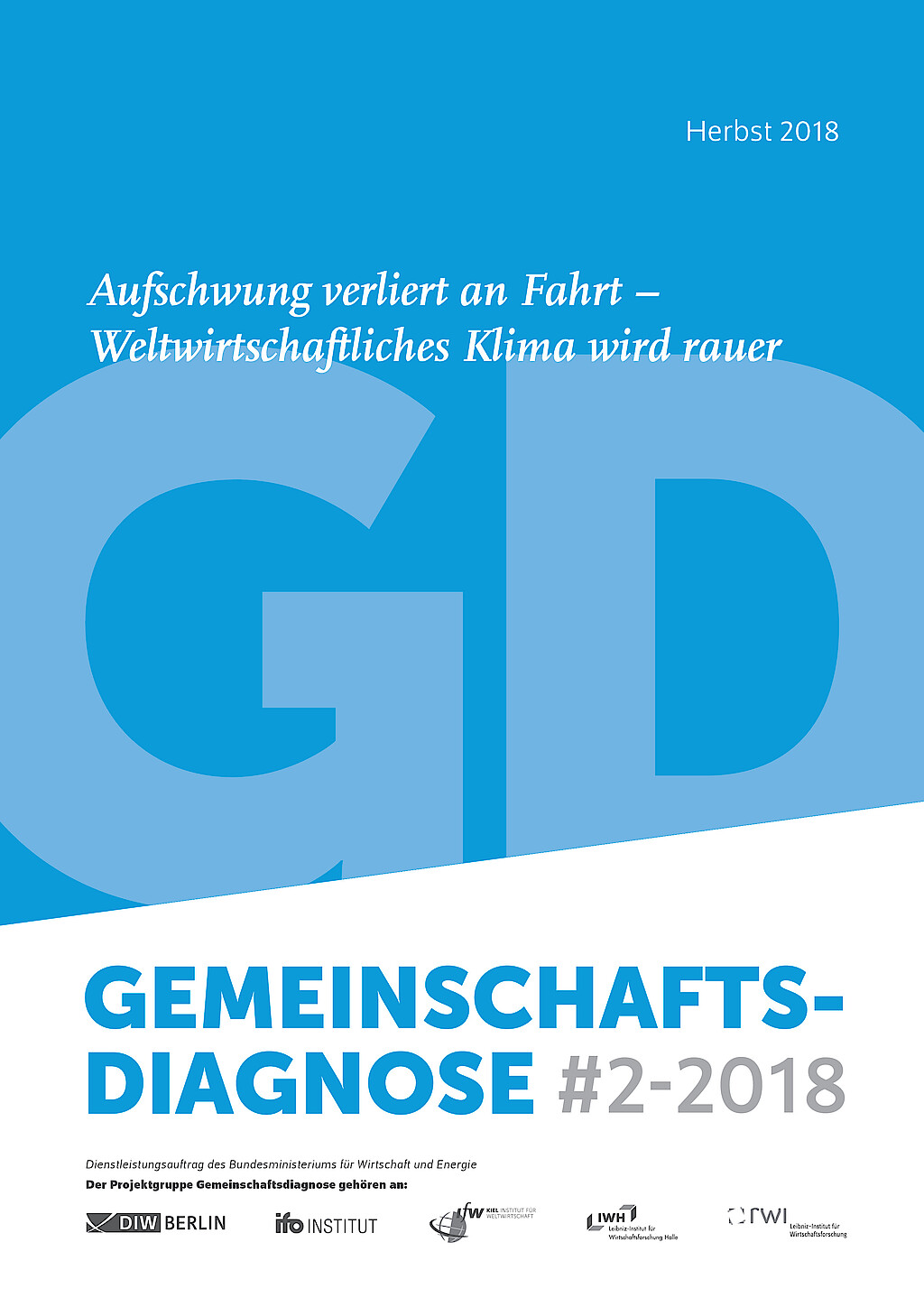
Upturn Loses Momentum – World Economic Climate Grows Harsher: Joint Economic Forecast Autumn 2018
Der Aufschwung in Deutschland geht in sein sechstes Jahr. Er hat allerdings an Fahrt eingebüßt. Dies hat sowohl nachfrageseitige als auch angebotsseitige Gründe. Zum einen hat sich das Auslandsgeschäft im Einklang mit der Verlangsamung der Konjunktur in den wichtigsten deutschen Absatzmärkten abgeschwächt. Zum anderen sehen sich Unternehmen allem Anschein nach zunehmend produktionsseitigen Engpässen gegenüber, vor allem bei Arbeitskräften und beim Bezug von Vorleistungsgütern. Überlagert wird dies durch Probleme in der Automobilindustrie im Zusammenhang mit der Einführung des neuen Prüfverfahrens WLTP, die aufgrund der hohen gesamtwirtschaftlichen Bedeutung der Branche sichtbare Spuren beim Zuwachs des Bruttoinlandsprodukts hinterlassen. Die Umstellungsprobleme dürften aber im Winterhalbjahr überwunden werden. Hinzu kommen Impulse aufgrund von finanzpolitischen Maßnahmen, die zum Jahresbeginn 2019 in Kraft treten. Im Durchschnitt dürfte die Wirtschaftsleistung nach einem Zuwachs um 1,7 Prozent in diesem Jahr mit Raten von 1,9 Prozent im Jahr 2019 und 1,8 Prozent im Jahr 2020 expandieren. Die Beschäftigung dürfte weiter spürbar, wenngleich mit abnehmendem Tempo ausgeweitet werden. Die registrierte Arbeitslosigkeit nähert sich gegen Ende des Prognosezeitraums wohl der Marke von 2 Millionen. Die Inflation wird sich dabei voraussichtlich von 1,8 Prozent im Durchschnitt dieses Jahres auf 2,0 Prozent im kommenden Jahr beschleunigen und 2020 bei 1,9 Prozent liegen. Trotz einer expansiv ausgerichteten Finanz-politik zeichnen sich für den Staat weiterhin Haushaltsüberschüsse ab, die allerdings von 54 Milliarden Euro auf 41 Milliarden Euro zurückgehen werden.
27. September 2018
Contents
Page 1
world economyPage 2
GermanyPage 3
risks for the German and international economy All on one pageA great deal of uncertainty weighs on future developments in the world economy in autumn 2018. Although global production continued to expand sharply up until summer 2018, the outlook has clouded over in recent months. On the one hand, the financial conditions for emerging economies are now less favourable due the withdrawal of international investors, with events even taking a crisis-like turn in Turkey and Argentina. On the other hand, trade conflicts are also casting a cloud over the outlook. Differences in the economic dynamics between countries have grown again since the beginning of the year. In the US the upturn regained impetus thanks to strong fiscal stimuli, while production was ramped up again considerably in China. In the euro area, by contrast, the economy lost impetus, especially in France and Italy.
World trade, which rose sharply at the end of 2017, has hardly expanded since the beginning of this year. However, this is only partly due to the deterioration in trade policy conditions. World trade had already been stagnating since the turn of the year, while US trade policy measures and the retaliatory tariffs imposed by other countries did not take effect until the summer. The measures taken to date also only affect a small group of goods. Lastly, the currencies of those countries affected by US tariffs since the onset of the trade conflict have mostly depreciated strongly against the US dollar, offsetting the loss in price competitiveness related to higher tariffs. However, the trade conflict will dampen the world economy due to its direct impact on trade, since it reduces confidence levels in the corporate sector.
The crude oil price rose sharply over the course of the year and was around 45% higher in August 2018 than during the same period a year previously. This triggered a sharp increase in consumer prices in the larger advanced economies. In the summer the inflation rate in the US reached almost 3%, slightly exceeding the Fed’s mid-term target inflation rate of around 2%. In Japan, however, inflation remained at 0.9%. The core inflation rate (adjusted for energy price components) has only risen in the US to date. In both Japan (0.3% in July) and in the euro area (1.3% in August) it remained almost unchanged.
The US stepped up the pace of tightening monetary policy due to the rising inflation rate. The Fed has already raised its target range for the Federal Funds Rate twice this year to its current level of 1.75 to 2.0%. It is also communicating that further increases are to be expected. As long as strong economic growth continues, the base rate will be 2.5-2.75% by the end of 2019, taking it to a level that is cyclically neutral. In the euro area and Japan, by contrast, base rates remain unchanged at 0%. The central banks are also scaling back their bond buying volumes. The ECB plans to completely phase out net buying by the end of 2018, but is not expected to raise its base rate until the second half of 2019. There are no signs of any interest rate increases for Japan yet.
In view of the expected monetary policy stance and the robust economy, capital market interest rates have risen in the US. For 10-year government bonds there is a 2.6 percent and 1.6 percentage point yield gap between US bonds and their respective German and British counterparts. At the same time, financial investments in the emerging economies have become less attractive. This has been accompanied by a significant drop in net capital inflows, which is weakening the economic dynamics in emerging economies. The fact that capital outflows can have self-amplifying effects is problematic, especially in cases where country-specific risks are perceived. This is currently the case in Argentina and Turkey. At the same time, the currencies in nearly all emerging economies have depreciated clearly in recent months, which may indicate that investors generally assess investments in this set of countries as riskier. Against this background, the economic risks for emerging economies have grown significantly, but a crisis-like escalation as seen during the Asian crisis of 1997/1998 is not expected. Most of the emerging economies are now less exposed than they were back then as they have scaled back their foreign currency debt considerably and their capital requirements for financing current account deficits are mostly small.
In advanced economies, fiscal policy is pronouncedly expansionary, especially in the US. It is also slightly expansionary in several euro area countries. Although the British government has loosened its austerity plans, it continues to pursue a slightly restrictive policy. In Japan there are plans to increase the value added tax rate from 8% to 10% in autumn, but the Japanese government wishes to use part of the additional revenues to finance additional public expenditure.
All in all, the institutes expect the world economy to continue on an upwards trend. Overall economic production in the countries covered by this report is expected to expand by 3.3% in 2018, followed by 3.0% in 2019 and 2.9% in 2020. The domestic economy remains the main driver in view of the monetary and fiscal policy pursued in most countries, while uncertainty concerning the world trade system will continue to have a negative impact. Globally, growth is expected to slow down over the forecasting horizon. The upturn in world trade will decline significantly to 3.4% in 2018, and is expected to reach 3% at best in the following two years.
After last year’s strong growth, the euro area’s economy weakened in the first half of 2018. This was due to a loss of impetus in exports after strong growth last year. Private consumption and fixed capital formation, by contrast, continued to grow at almost the same pace as in 2017 during the first half of 2018. At the beginning of the third quarter, problems with the switch to the new emissions testing standard WLTP negatively impacted production in the automotive industry, which had a knock-on effect on the entire economy. Fiscal policy will provide stimuli for the economy over the forecasting horizon. Favourable financing conditions and high capacity utilisation levels will trigger more investment. Continued improvements in the labour market and rising wages will boost consumer spending. The increase in gross domestic product will total 2.0% this year, followed by 1.8% in 2019 and 1.6% in 2020. The upturn is expected to continue in the euro area, although it will lose impetus. Expansion will mainly be driven by the domestic economy.





